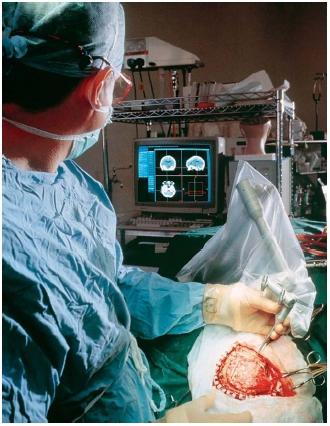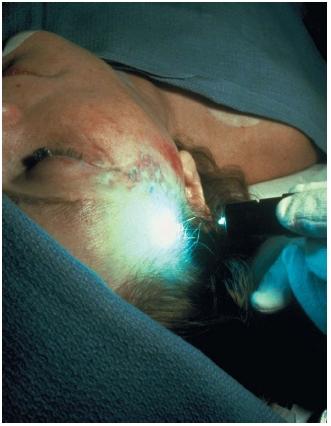Surgery
Surgery is the treatment of disease or injury by cutting into the body to repair or remove the injured or diseased body part. Surgery is usually performed by surgeons in the operating room of a hospital or clinic.
Ancient surgeons
Surgery has been performed since ancient times. The earliest surgical operations were circumcision (removal of the foreskin of the penis) and trepanation (cutting a hole in the skull for the release of pressure or "demons"). Stone Age skulls bearing holes from trepanning have been found around the world. The ancient Egyptians practiced surgery as early as 2500 B.C. using sharp instruments made of copper. The ancient Hindus of India excelled at surgery, performing tonsillectomies, plastic surgery, and removal of bladder stones and cataracts (a clouding of the lens of the eye). The Greeks and Romans used a variety of instruments, including forceps, knives, probes, and scalpels, to operate on wounds and amputate limbs.
During the Middle Ages (400–1450), medical knowledge slowed, and those performing operations, called barber-surgeons, often possessed little education or skill. Without knowledge of antisepsis (techniques to prevent infection), surgery was extremely risky and often resulted in complications or death of the patient.
After the Middle Ages, efforts were made to elevate the status of surgery to a level of some prestige and professionalism. Instrumental in this effort was the great French surgeon Ambroise Paré (1517–1590). Paré introduced the use of ligature (material such as thread or wire) for the tying of blood vessels to prevent excessive bleeding during amputations. His medical writings, which include information on anatomy and discussion of new surgical techniques, greatly influenced his fellow barber-surgeons and advanced the surgical profession.
Era of modern surgery
The era of modern surgery began in the nineteenth century with the introduction of anesthesia (techniques to lessen pain), antiseptic methods, and sterilization of instruments. The discovery of the X ray in 1895 gave surgeons an invaluable diagnostic tool. X rays are a form of radiation that can penetrate solids and are used to generate images of bones and other tissues. Diagnoses using X rays were followed by diagnoses using ultrasound, computerized axial tomography (CAT) scanning, and magnetic resonance imaging (MRI).
Words to Know
Anesthesia: Method of decreasing sensitivity to pain in a patient so that a medical procedure may be performed.
Barber-surgeon: Name given to often unskilled and uneducated persons who practiced surgery during the Middle Ages.
Computerized axial tomography (CAT scan): An X-ray technique in which a three-dimensional image of a body part is put together by computer using a series of X-ray pictures taken from different angles along a straight line.
Endoscope: Instrument for examining internal body cavities or organs.
Laser: A device that sends out a high-intensity beam of light.
Ligature: Material such as thread used to tie a blood vessel or bind a body part.
Magnetic resonance imaging (MRI): A technique for producing computerized three-dimensional images of tissues inside the body using radio waves.
Trepanation: The removal of a circular piece of bone, usually from the skull.
Ultrasound: A diagnostic technique that uses sound waves to produce an image.
X ray: A form of electromagnetic radiation that can penetrate solids that are used to generate images of bones and other tissues.
Surgery advances in the twentieth century include techniques for performing blood transfusions, brain and heart operations (such as bypass surgery and valve replacement), organ transplantation, microsurgery, and laser surgery. Microsurgery allows surgeons to perform precise, delicate operations on various body structures while viewing the surgical area through a microscope. Lasers, high-intensity beams of light focused at targeted tissues, are used to treat eye disorders, break up kidney stones and tumors, and remove birthmarks, wrinkles, and spider veins.
Some types of surgery that previously required extensive cutting through body tissue can now be accomplished using less invasive techniques. Endoscopic surgery is a method of operating on internal body structures, such as knee joints or reproductive organs, by passing an instrument called an endoscope through a body opening or tiny incision. Tiny surgical instruments and a miniature video camera, allowing viewing of the area to be operated on, are attached to the endoscope.
Plastic surgery, including cosmetic surgery, has flourished in the twentieth century. Plastic surgery is the reconstruction or repair of damaged

tissue due to injury, birth defects, severe burns, or diseases such as cancer. Cosmetic surgery is increasingly popular for both men and women and includes facelifts, breast enlargement and reduction, nose reshaping, and liposuction (removal of fat from tissues).
A dramatic advance in recent years is fetal surgery, in which procedures such as blood transfusions or correction of a life-threatening hernia (rupture) or urinary tract obstruction are performed on the unborn fetus while the mother is under general anesthesia.
[ See also Plastic surgery ]
